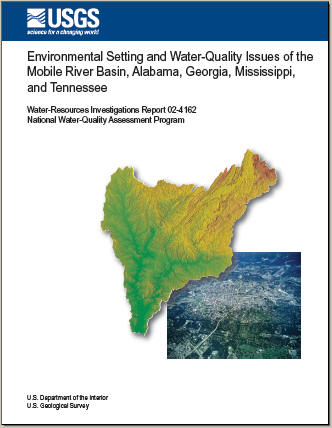Water-Resources Investigations Report 02-4162
U.S. Geological Survey Water-Resources Investigations Report 02-4162, 120 pages (Published 2002)
NATIONAL WATER-QUALITY ASSESSMENT PROGRAM
Gregory C. Johnson, Robert E. Kidd, Celeste A. Journey, Humbert Zappia, and J. Brian Atkins
![]() This report is available online in pdf format: USGS WRIR 02-4162 (28 MB)
This report is available online in pdf format: USGS WRIR 02-4162 (28 MB)

The Mobile River Basin is one of over 50 river basins and aquifer systems being investigated as part of the U.S. Geological Survey National Water-Quality Assessment (NAWQA) Program. This basin is the sixth largest river basin in the United States, and fourth largest in terms of streamflow, encompassing parts of Alabama, Georgia, Mississippi, and Tennessee. Almost two-thirds of the 44,000-square-mile basin is located in Alabama. Extensive water resources of the Mobile River Basin are influenced by an array of natural and cultural factors. These factors impart unique and variable qualities to the streams, rivers, and aquifers providing abundant habitat to sustain the diverse aquatic life in the basin.
Data from Federal, State, and local agencies provide a description of the environmental setting of the Mobile River Basin. Environmental data include natural factors such as physiography, geology, soils, climate, hydrology, ecoregions, and aquatic ecology, and human factors such as reservoirs, land use and population change, water use, and water-quality issues. Characterization of the environmental setting is useful for understanding the physical, chemical, and biological characteristics of surface and ground water in the Mobile River Basin and the possible implications of that environmental setting for water quality.
The Mobile River Basin encompasses parts of five physiographic provinces. Fifty-six percent of the basin lies within the East Gulf section of the Coastal Plain Physiographic Province. The remaining northeastern part of the basin lies, from west to east, within the Cumberland Plateau section of the Appalachian Plateaus Physiographic Province, the Valley and Ridge Physiographic Province, the Piedmont Physiographic Province, and the Blue Ridge Physiographic Province.
Based on the 1991 land-use data, about 70 percent of the basin is forested, while agriculture, including livestock (poultry, cattle, and swine), row crops (cotton, corn, soybeans, sorghum, and wheat), and pasture land accounts for about 26 percent of the study unit. Agricultural land use is concentrated along the Black Prairie Belt district of the Coastal Plain. Urban areas account for only 3 percent of the total land use; however, the areal extent of the metropolitan statistical areas (MSA) may indicate more urban influences. The MSAs include urban areas outside of the city boundaries and can include adjacent counties. Seven MSAs are delineated in the Mobile River Basin, including Montgomery, Mobile, Tuscaloosa, Birmingham, Gadsden, Anniston, and Atlanta. The total population for the Mobile River Basin was about 3,673,100 in 1990.
State water-quality agencies have identified numerous causes and sources of water-body impairment in the Mobile River Basin. In 1996, organic enrichment, dissolved oxygen depletion, elevated nutrient concentrations, and siltation were the most frequently cited causes of impairment, affecting the greatest number of river miles. Bacteria, acidic pH, and elevated metal concentrations also were identified as causes of impairment. The sources for impairment varied among river basins, were largely a function of land use, and were attributed primarily to municipal and industrial sources, mining, and agricultural activities.
Abstract
Introduction
Purpose and Scope
Acknowledgments
Environmental Setting of the Mobile River Basin
Natural Factors
Physiography
Non-Coastal Plain Physiographic Provinces
Blue Ridge and Piedmont Physiographic Provinces
Valley and Ridge Physiographic Province
Cumberland Plateau
Coastal Plain Physiographic Province
Geology
Soils
Climate
Hydrology
Surface Water
Streamflow Characteristics
Mean Annual Runoff
Ground Water
Southeastern Coastal Plain Aquifer System
Valley and Ridge Aquifers
Appalachian Plateaus Aquifers
Piedmont and Blue Ridge Aquifers
Ecoregions
Aquatic Ecology
Cultural Factors
Study Unit Stratification
Reservoirs
Land Use
Agriculture
Urban
Mining
Water Use
Water-Quality Issues
State 305(b) Reports
Toxics Release Inventory
Summary
References
Appendix A. Aquatic species extirpated from or extinct in the Mobile River Basin
Appendix B. Aquatic species in the Mobile River Basin listed under the Endangered Species Act of 1973
![]() This report is available online in pdf format: USGS WRIR 02-4162 (28 MB)
This report is available online in pdf format: USGS WRIR 02-4162 (28 MB)
To view the PDF document, you need the free Adobe Acrobat® Reader installed on your computer.
Johnson, Gregory C.; Kidd, Robert E.; Journey, Celeste A.; Zappia, Humbert; Atkins, J. Brian , 2002, Environmental Setting and Water-Quality Issues of the Mobile River Basin, Alabama, Georgia, Mississippi, and Tennessee: U.S. Geological Survey Water-Resources Investigations Report 02-4162, 120 p.
[an error occurred while processing this directive]